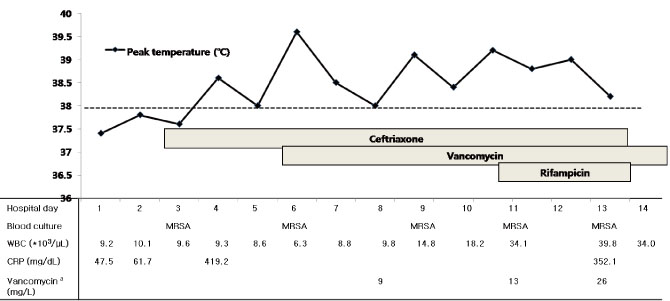Infect Chemother.
2010 Aug;42(4):249-252. 10.3947/ic.2010.42.4.249.
Fatal Peripheral Septic Thrombophlebitis Complicated with Infective Endocarditis due to Methicillin-resistant Staphylococcus aureus: A Case Report with Autopsy Findings
- Affiliations
-
- 1Division of Infectious Diseases, Department of Internal Medicine, Korea University College of Medicine, Seoul, Korea. macropha@korea.ac.kr
- 2Department of Pathology, Korea University College of Medicine, Seoul, Korea.
- KMID: 1457387
- DOI: http://doi.org/10.3947/ic.2010.42.4.249
Abstract
- Persistent methicillin-resistant Staphylococcus aureus bacteremia (PMRSAB) has recently become a serious problem in patient care. However, it is an unusual complication of peripheral thrombophlebitis. An 80-year-old woman with head trauma suffered from suppurative thrombophlebitis on the insertion site of a peripheral venous catheter of her right wrist. She died of septic shock following fatal PMRSAB. Autopsy was requested to evaluate the extent of the infection, and disclosed septic thrombophlebitis with abscess formation in the right wrist and infective endocarditis on the leaflets of mitral valve.
MeSH Terms
Figure
Cited by 1 articles
-
Clinical Guideline for the Diagnosis and Treatment of Cardiovascular Infections
, , , ,
Infect Chemother. 2011;43(2):129-177. doi: 10.3947/ic.2011.43.2.129.
Reference
-
1. Ringberg H, Thorén A, Lilja B. Metastatic complications of Staphylococcus aureus septicemia. To seek is to find. Infection. 2000. 28:132–136.
Article2. Chang FY, MacDonald BB, Peacock JE Jr, Musher DM, Triplett P, Mylotte JM, O'Donnell A, Wagener MM, Yu VL. A prospective multicenter study of Staphylococcus aureus bacteremia: incidence of endocarditis, risk factors for mortality, and clinical impact of methicillin resistance. Medicine (Baltimore). 2003. 82:322–332.3. Jang HC, Kim SH, Kim KH, Kim CJ, Lee S, Song KH, Jeon JH, Park WB, Kim HB, Park SW, Kim NJ, Kim EC, Oh MD, Choe KW. Salvage treatment for persistent methicillin-resistant Staphylococcus aureus bacteremia: efficacy of linezolid with or without carbapenem. Clin Infect Dis. 2009. 49:395–401.
Article4. Hawkins C, Huang J, Jin N, Noskin GA, Zembower TR, Bolon M. Persistent Staphylococcus aureus bacteremia: an analysis of risk factors and outcomes. Arch Intern Med. 2007. 167:1861–1867.
Article5. Khatib R, Johnson LB, Sharma M, Fakih MG, Ganga R, Riederer K. Persistent Staphylococcus aureus bacteremia: incidence and outcome trends over time. Scand J Infect Dis. 2009. 41:4–9.
Article6. Cosgrove SE, Sakoulas G, Perencevich EN, Schwaber MJ, Karchmer AW, Carmeli Y. Comparison of mortality associated with methicillin-resistant and methicillin-susceptible Staphylococcus aureus bacteremia: a meta-analysis. Clin Infect Dis. 2003. 36:53–59.
Article7. Lee SO, Kim ES, Kim HY, Park ES, Jin HY, Ki HK, Choi HJ, Jeong SY, Kim SR, Kim S, Uh Y, Pai H, Lee YS, Oh HB, Choi TY. Korean Nosocomial Infections Surveillance System (KONIS). Korean nosocomial infections surveillance system, Intensive care unit module report: data summary from July 2007 through June 2008. Korean J Nosocomial Infect Control. 2008. 13:69–82.8. Villani C, Johnson DH, Cunha BA. Bilateral suppurative thrombophlebitis due to Staphylococcus aureus. Heart Lung. 1995. 24:342–344.9. Mylotte JM, Tayara A. Staphylococcus aureus bacteremia: predictors of 30-day mortality in a large cohort. Clin Infect Dis. 2000. 31:1170–1174.
Article10. Benito N, Miró JM, de Lazzari E, Cabell CH, del Río A, Altclas J, Commerford P, Delahaye F, Dragulescu S, Giamarellou H, Habib G, Kamarulzaman A, Kumar AS, Nacinovich FM, Suter F, Tribouilloy C, Venugopal K, Moreno A, Fowler VG Jr. ICEPCS (International Collaboration on Endocarditis Prospective Cohort Study) Investigators. Health care-associated native valve endocarditis: importance of non-nosocomial acquisition. Ann Intern Med. 2009. 150:586–594.
Article11. Fowler VG Jr, Li J, Corey GR, Boley J, Marr KA, Gopal AK, Kong LK, Gottlieb G, Donovan CL, Sexton DJ, Ryan T. Role of echocardiography in evaluation of patients with Staphylococcus aureus bacteremia: experience in 103 patients. J Am Coll Cardiol. 1997. 30:1072–1078.
Article12. Bessette EL, Ahern JW, Alston WK. Risk factors for persistence methicillin-resistant Staphylococcus aureus bacteremia despite treatment with vancomycin. Infect Dis Clin Pract. 2007. 15:174–177.
Article13. Yoon YK, Kim JY, Park DW, Sohn JW, Kim MJ. Predictors of persistent methicillin-resistant Staphylococcus aureus bacteraemia in pat ients t reated with vancomycin. J Antimicrob Chemother. 2010. 65:1015–1018.
Article14. Arnow PM, Quimosing EM, Beach M. Consequences of intravascular catheter sepsis. Clin Infect Dis. 1993. 16:778–784.
Article15. Stein JM, Pruitt BA Jr. Suppurative thrombophlebitis. A lethal iatrogenic disease. N Engl J Med. 1970. 282:1452–1455.16. O'Grady NP, Alexander M, Dellinger EP, Gerberding JL, Heard SO, Maki DG, Masur H, McCormick RD, Mermel LA, Pearson ML, Raad II, Randolph A, Weinstein RA. Guidelines for the prevention of intravascular catheter-related infections. Centers for Disease Control and Prevention. MMWR Recomm Rep. 2002. 51:1–29.17. Hammond JS, Varas R, Ward CG. Suppurative thrombophlebitis: a new look at a continuing problem. South Med J. 1998. 81:969–971.
Article18. Quale JM, Mandel LJ, Bergasa NV, Straus EW. Clinical significance and pathogenesis of hyperbilirubinemia associated with Staphylococcus aureus septicemia. Am J Med. 1988. 85:615–618.
Article
- Full Text Links
- Actions
-
Cited
- CITED
-
- Close
- Share
- Similar articles
-
- A Fatal Case of Infective Endocarditis Caused by Community-Associated Methicillin-Resistant Staphylococcus aureus ST72 in Korea
- Community-acquired Methicillin-resistant Staphylococcus aureus Bacteremia Complicated by Acute Cholecystitis
- Septic Arthritis and Infective Endocarditis in an Adolescent Hemophilia B Patient with an Inhibitor and a Central Venous Access Device
- Methicillin-resistant Staphylococcus aureus Endocarditis after Sigmoidoscopy
- A case of tricuspid valve endocarditis with septic pneumonia caused by methicillin-resistant Staphylococcus aureus in a healthy woman




